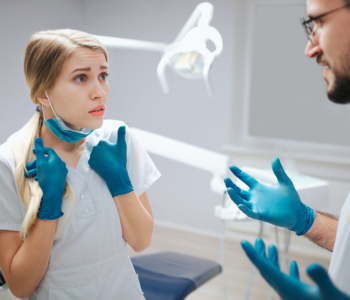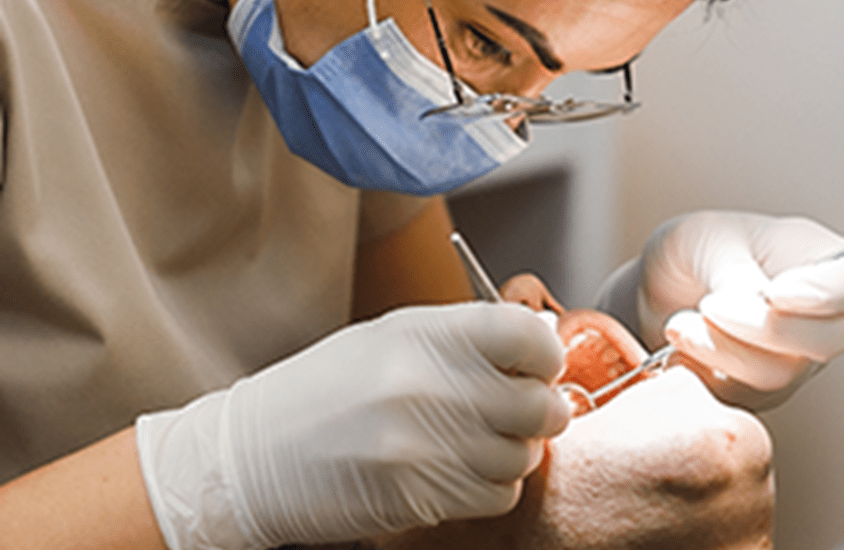
Gestión de la práctica
Los conflictos en el lugar de trabajo son tóxicos para el equipo, los pacientes y la práctica. Descubre cómo mantener la paz en tu oficina.
11 minutos de lectura

Dental membranes are known to improve the prognosis in procedures involving periodontal tissue regeneration and bone augmentation.1 However, their use in bone regeneration is surprisingly low, featuring in only 25-30% of bone grafting procedures performed today. Here, we make the case for using a dental membrane in your bone grafting procedures.
Guided bone regeneration (GBR) is a surgical technique used to increase alveolar bone volume. It is most commonly used to preserve the socket after an extraction to support the future placement of dental implants. It may also be used around an existing dental implant to repair small bony defects or promote bone growth.
The term “guided” refers to the use of a barrier membrane in addition to a bone graft. In the context of socket preservation, GBR involves filling the socket with a bone substitute and covering the material with a membrane, which protects the graft site and guides the creation of new bone tissue.
GBR is also referred to as guided tissue regeneration, or GTR. However, it is important to note that GTR may refer to the regeneration of both the hard and soft tissues of the oral cavity, while GBR refers specifically to the bony tissue.
GBR and socket preservation
Alveolar bone resorption is an inevitable consequence of tooth extraction. In the 2-3 years after extraction, approximately 40-60% of alveolar height and width is lost, with most of the resorption occurring during the first 3-6 months.2,3,4,5 Bone loss continues at a rate of 0.25-1% until death.2,4,5
For the patient, this has both functional and aesthetic implications. Should they wish to have dental implants or other prosthetic procedures at a later date, the alveolar ridge may not provide adequate support. The patient may require expensive and stressful surgical interventions in order to facilitate the desired treatment, and assumes a greater risk of complications and implant failure. Tooth and alveolar bone loss can also alter the structure of the face, give a prematurely aged appearance, and impact the individual’s self-confidence.
Regardless of whether or not the patient intends to have implants at the point of extraction, socket preservation should always be considered. Various studies have demonstrated that socket-preserving bone grafts notably reduce the rate of resorption of alveolar bone and prevent the subsequent recession of the interdental papilla, preserving the necessary height, width, and density of the alveolar ridge for future implant placement.4,5
The case for using a membrane
Socket-preserving bone grafts can be performed without the use of a barrier membrane; indeed, up to 75% of bone regeneration procedures are. However, there are several compelling reasons why membranes should be a routine step in bone regeneration.
Clotting and wound stabilisation
Immediately after extraction, platelet aggregation begins at the wound site, a clot begins to develop and stabilise, and angiogenesis begins.3,5,6,7 Platelets in the clot release cytokines, growth factors, and signalling molecules, recruiting clearing cells to the wound site to initiate healing. Certain growth factors also promote the differentiation of mesenchymal cells. Highly vascular granulation tissue then begins to replace the clot, marking the site at which newly differentiated cells will begin to form new bone.
Blood clot formation and stabilisation is therefore a critical step in post-extraction healing and bone regeneration, one that significantly benefits from the use of a membrane. Collagen membranes, for example, promote platelet aggregation and act as a scaffold to secure the clot, and they assist in cell recruitment to the wound site.5,6 Further, membranes can protect the clot from mechanical disruption and prevent salivary contamination of the wound.7 When used in conjunction with bone material grafts, membranes show predictable, reliable wound healing and bone formation.6
Space creation for bone ingrowth
For the successful regeneration of alveolar bone, the rate of osteogenesis must exceed the rate of fibrogenesis from the surrounding epithelial and connective tissues.7 This occurs in natural bone formation, where the bone develops in an enclosed space with limited infiltration of epithelial or connective tissue cells, allowing for uninhibited bone formation. However, in the case of bone regeneration procedures, the wound is largely unprotected from such infiltration.
Placing a barrier membrane over the bone graft creates a secluded space that mimics the natural conditions necessary for bone formation. It excludes epithelial and connective tissue cells from the wound while allowing the proliferation of osteoblasts, the cells primarily responsible for bone formation. In doing so, membranes have been shown to result in enhanced bone formation and prevent the resorption of bone graft material.6,7 Alveolar height and width loss in the presence of a membrane has been shown to be considerably less than in sockets left to heal naturally, with bone quality also deemed ideal for later implant placement.3,4,8 In one particular study, bone grafts lost up to 35% density by 16 weeks when placed without a membrane, compared to only 10% loss with a membrane.9 On the other hand, it has been shown that compromised membranes (exposed or collapsed) are associated with lower levels of bone regeneration.6
Current barrier membrane solutions
At present, available membranes can be grouped into two categories: non-resorbable and resorbable.
Non-resorbable membranes are commonly made from expanded polytetrafluoroethylene (ePTFE) or and high-density polytetrafluoroethylene (d-PTFE), and may be reinforced with titanium. Thus, they offer excellent structural integrity, space maintenance, and wound protection, with predictable bone formation.10 However, non-resorbable membranes will remain in place until removed, which requires a second surgery. Further, the risk of wound dehiscence and infection is high, and the membrane must be removed if exposed. Such complications can result in additional treatment, cost, and distress to the patient.
Resorbable membranes, traditionally made from porcine or bovine collagen, are popular alternatives to non-resorbable membranes. Collagen demonstrates excellent bioactive qualities beneficial to socket preservation and bone regeneration, and is shown to:5,10
While not as strong as reinforced non-resorbable membranes, resorbable membranes are shown to effectively maintain space needed for bone regeneration.10 As the membrane breaks down in the body over time, a second surgery is not required for removal, sparing the patient additional trauma and recovery time and reducing treatment time for the dental professional.
However, resorbable membranes made with collagen do present some challenges. Notably, as with any animal-derived product, there is a risk of animal-to-human pathogen transmission. Some patients also object to the use of animal products for religious, lifestyle, or cultural reasons, excluding them from a procedure that could otherwise be of great value to them.
The synthetic solution
Synthetic resorbable membranes like R.T.R.+ Membrane represent an exciting breakthrough in guided bone regeneration, offering the same biological benefits of resorbable collagen membranes with none of the drawbacks.
Innovative bilayer design
Developed with a proprietary process using the very latest advances in tissue engineering, R.T.R.+ Membrane* features an innovative bilayer design. The smooth, dense upper layer creates a protective barrier to guard against soft tissue infiltration, ensuring only new bone growth populates the wound space. Meanwhile, the lower layer features an intricate network of polymer microfibres that perfectly mimic the structure of collagen, providing a strong 3D matrix to support early cell colonisation, attachment, and vascularisation. With 85% porosity, the biomimetic scaffold protects the space without excluding the cells necessary for regeneration and healing.
Easy handling
Resorbable collagen membranes are notoriously difficult to shape, place, and suture. R.T.R.+ Membrane, on the other hand, is supple and strong for easy handling and placement. It maintains the same physical properties whether wet or dry, retaining its shape and structure on contact with blood. And because it demonstrates excellent adhesion to the tissues, there’s no need to pin or suture the membrane in place.
No second surgery
Made from 100% polymer poly-D,L-lactic/glycolic acid (PLGA) derived from tapioca, corn, or sugar starches, R.T.R.+ Membrane is biocompatible and biodegradable yet strong. It maintains its structural integrity and provides a barrier effect for 4-6 weeks after placement, with bone and soft tissue regeneration continuing for a further 4-6 months.11 When tissue regeneration is complete, the PLGA material degrades via hydrolysis into lactic and glycolic acids that are naturally found in the body. For the patient, this means that a second surgery to remove the membrane is not necessary, as it would be with a non-resorbable membrane.
Further, the material is resistant to the enzymes found in saliva and will not degrade on contact. If the sutures rupture and the membrane is exposed, then, there is no need for surgical intervention. The membrane can simply be left in place, where it will continue to guide the tissues to heal and regenerate.
A universal solution for every patient
Finally, R.T.R.+ Membrane is completely free from animal-derived products. It eliminates the risk of animal-to-human pathogen transmission entirely and presents an agreeable option to those averse to animal products. For your patients, that means everyone can enjoy the benefits of the latest in bone regeneration technology without compromise.
Conclusion
When a tooth is extracted, the patient may not always be in the position to plan for the future. However, dental professionals can. By offering socket preservation according to the principles of guided bone regeneration, practitioners can ensure that the option for dental implants remains available whenever the patient should want it. And by pairing a resorbable synthetic membrane like R.T.R.+ Membrane with Septodont’s R.T.R.+ synthetic bone substitute, they finally have a full synthetic range for bone grafting procedures — for every patient.
*Indications from the IFU
References
1 Sasaki, J.I. et al. (2021) ‘Barrier membranes for tissue regeneration in dentistry’, Biomaterial Investigations in Dentistry, 8(1), pp. 54-63. doi: 10.1080/26415275.2021.1925556.
2 Ashman, A. (2000) ‘Postextraction ridge preservation using a synthetic alloplast’, Journal of Implant Dentistry, 9(2), pp. 168-76. doi: 10.1097/00008505-200009020-00011.
3 Irinakis, T. (2006) ‘Rationale for Socket Preservation after Extraction of a Single-Rooted Tooth when Planning for Future Implant Placement’, Journal of the Canadian Dental Association, 72(10), pp. 917 – 22.
4 Pagni, G. (2012) ‘Postextraction Alveolar Ridge Preservation: Biological Basis and Treatments’, International Journal of Dentistry. doi: 10.1155/2012/151030.
5 Lin, H.K. et al. (2019) ‘Prevention of Bone Resorption by HA/β-TCP + Collagen Composite after Tooth Extraction: A Case Series’, International Journal of Environmental Research and Public Health, 16(23), pp. 4616. doi: 10.3390/ijerph16234616.
6 Wang, H.L. (2006) ‘“PASS” Principles for Predictable Bone Regeneration’, Journal of Implant Dentistry, 15(1), pp. 8-17. doi: 10.1097/01.id.0000204762.39826.0f.
7 Liu, J. & Kerns, D.G. (2014) ‘Mechanisms of Guided Bone Regeneration: A Review’, The Open Dentistry Journal, 16(8), pp. 56-65. doi: 10.2174/1874210601408010056.
8 Avila-Ortiz, G. et al. (2014) ‘Effect of Alveolar Ridge Preservation after Tooth Extraction: A Systematic Review and Meta-analysis’, Journal of Dental Research, 93(10), pp. 950-8. doi: 10.1177/0022034514541127.
9 Kim, M. et al. (2008) ‘Effect of Bone Mineral with or without Collagen Membrane in Ridge Dehiscence Defects Following Premolar Extraction’, In Vivo, 22, pp. 231-236.
10 Kim, Y.K. & Ku, J.K. (2020) ‘Guided bone regeneration’, Journal of the Korean Association of Oral and Maxillofacial Surgeons, 46(5), pp. 361-366. doi: 10.5125/jkaoms.2020.46.5.361
11 Internal data: Resorption time measured in animal experimentation after subcutaneous application of the membrane in rats.
El sitio al que está a punto de acceder está restringido a profesionales sanitarios. Al hacer clic en Aceptar, usted certifica que es un profesional de la salud.